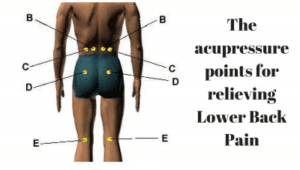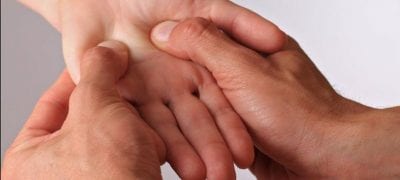Also known as reflexology, acupressure is the healing technique of stimulating reflex points on certain parts of the body that correlate to vital organs . Developed in Asia over 5,000 years ago, it is considered an ancient healing method that employs the use of the fingers, the hands, or the elbows to gently press key healing points, thereby stimulating the body’s natural self-curative capabilities. Stimulating these points with acupressure allows healing energy to flow to those specific organs to help the body heal itself. This form of alternative treatment is typically used to alleviate stress-related ailments and is also good for the skin. Acupressure, chiropractic, and acupuncture treatments originated in China.
 There are various types of acupressure techniques. Jin shin acupressure is characterized by holding at least two pressure points for a minute or more; it employs the “extra meridians” or “extraordinary vessels”, which balance the meridians. Shiatsu therapy, the traditional Japanese form of acupressure, is known as a hard massage, with deep pressure applied to each point for three to five seconds.
There are various types of acupressure techniques. Jin shin acupressure is characterized by holding at least two pressure points for a minute or more; it employs the “extra meridians” or “extraordinary vessels”, which balance the meridians. Shiatsu therapy, the traditional Japanese form of acupressure, is known as a hard massage, with deep pressure applied to each point for three to five seconds.
The 12 meridians of traditional Chinese medicine are the pathways of the body’s healing energy. Life energy is moved through these meridians to improve flow and balance, regulating blood circulation and optimizing the functions of the body’s organs. When life force properly flows through the meridians, the person can be ensured of happiness, harmony, and health.
Acupressure points have a high electrical conductivity at the surface of the skin, thus conducting healing energy in the most effective way possible. In China, healing energy is called qi or chi, while in Japan, the life force is termed ki and the healing energy is called reiki. Yoga practices, on the other hand, call the body’s life force prana or pranic energy.
Health benefits of acupressure
 Acupressure is generally used to relieve stress-related ailments. It is highly effective for relieving muscular pain in the back. The back is most sensitive at the upper corner and along either side of the spine. To release tightness within the lower back and the sciatica (begins from nerve roots in the lumbar spinal cord in the low back and extends through the buttock area), lie down on a couple of tennis balls tied in a sock.
Acupressure is generally used to relieve stress-related ailments. It is highly effective for relieving muscular pain in the back. The back is most sensitive at the upper corner and along either side of the spine. To release tightness within the lower back and the sciatica (begins from nerve roots in the lumbar spinal cord in the low back and extends through the buttock area), lie down on a couple of tennis balls tied in a sock.
Acupressure is good for the skin. It enhances muscle tone and increases blood circulation, thereby preventing the growth of wrinkles even without the help of medication or surgery.
Acupressure is good for emotional health. It relaxes the tight muscles that the body gets due to emotional stress and trauma. You see, when you feel that there’s something wrong with you emotionally, your body is also affected in the sense that it contracts its muscles and harden. This tension hinders energy from circulating freely in your body, which can cause physical and emotional imbalances.
Like emotional burdens, muscle tightness can be bad for the body if not dealt with immediately as they can resurface at a later time, when they’re triggered by a new stress.
Divorce is a traumatic life event that can result in emotional problems such as anxiety, depression, or worry and also result in physical symptoms such as irritable bowel problems, stomachaches, ulcers, among others. Acupressure can help alleviate these symptoms.
Acupressure can also help in curbing addiction, since it eases pain, relieves stress and tension, and heightens body awareness.
Acupressure coupled with qi gong (a system of coordinated body posture and movement, breathing, and meditation) facilitates optimal internal healing.
Body systems supported by acupressure
 Acupressure is good for the immune system. It creates effects that serve to strengthen the body in its fight against diseases and infection. It also balances body energy.
Acupressure is good for the immune system. It creates effects that serve to strengthen the body in its fight against diseases and infection. It also balances body energy.
Acupressure is good for the circulatory system. It provides for a more optimal flow and transport of blood throughout various canals and channels of the body.
Since acupressure is good for meridian pathways, it provides for the proper functioning of the body’s systems including the endocrine, reproductive, digestive, nervous, and vascular, among others.
The miracles of acupressure for children
Acupressure isn’t just for adults. People of all ages can benefit from the ancient healing method of acupressure, even small children and babies. Because their bodies are still underdeveloped and highly sensitive, babies and small children can be prone to certain health problems. On the other hand, this heightened sensitivity also allows them to respond especially well to acupressure. When applied correctly, it brings them instant relief and helps them relax.
Acupressure can be used to alleviate pain and symptoms relating to a number of health problems, but it can also be utilized as a preventive maintenance tool for good health. It can additionally be used to gently correct conditions from birth. Some babies experience a difficult birthing procedure when they undergo a forceps delivery or if a ventouse is used on them. The bones of newborns are tiny and fragile and the use of such birthing instruments puts considerable amounts of pressure on their skulls. This can cause their skulls to be marginally misaligned. Fortunately, this can be remedied with the gentle application of acupressure.
Health benefits of acupressure for small children
Physical contact with babies is necessary for their well-being as it promotes healthy psychological and physical development. Acupressure is a very good way to provide regular physical interaction between you and your baby. At the same time, it is important that acupressure be applied very gently and carefully to babies and small children as their body parts are still tender and delicate. Gently apply pressure on the key healing points for around 10 minutes a day, with a maximum of 20 minutes. Here are some ways acupressure can be used to benefit small children:
- Constipation. If your baby hasn’t been burped adequately, he/she may be experiencing bloating or colic pain. You can ease this pain and aid in digestion by gently tapping your baby’s tummy, around an inch away from the navel. Next, slightly tap each side of the belly button 10 times then let your finger wander around in a circle around an inch in diameter. Lastly, massage in a circle 10 inches from the belly using a clockwise motion.
- Congestion. Congested nasal passages can be quite a nuisance for infants. It makes it difficult to eat or breathe. Gently massage the area on either side of their nose in a circular motion to the count of 10. Repeat this process every two to three hours, up to six times a day to reduce inflammation of the nasal passages. (Related: Using acupressure to remedy a stuffy nose.)
- Teething pain. When your baby’s milk teeth begin to appear, they may experience teething pain. Let your baby welcome this change more comfortably by gently pressing the largest part of your baby’s palms near the thumbs. Lightly massage this area for 10 seconds and repeat every two hours.
- Sleeping problems. Children can get fussy during bedtime. Help your child drift off to dreamland by softly stroking the area between their eyebrows with your forefinger for around 10 to 20 seconds.
- Coughing. A chronic cough can make your baby restless. Ease their coughing by gently holding the tops of their index fingers for around five seconds. This should help reduce the frequency of their coughing fits.
Where to learn more:
- AlternativeMedicine.news.
- Acupressure could calm patients with dementia, study finds
- Acupressure vs. high blood pressure: This holistic route is 100 percent drug-free
- Acupressure Wristbands Help Cancer Patients
- Acupressure Provides Many Benefits to Dogs and Other Pets
- Acupressure can prevent brain shrinkage in back pain sufferers (press release)
Sources:



